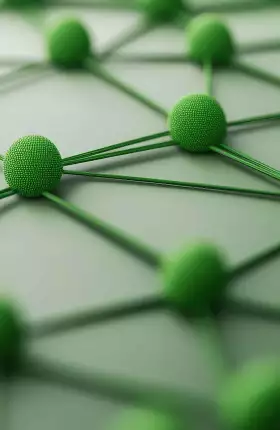Marketing has reached a paradigm-shifting moment. Digital transformation has fractured consumer journeys into unpredictable, nonlinear patterns, and AI’s rise will only intensify this complexity. But AI isn’t just a source of disruption—it’s an unprecedented opportunity. To build a lasting competitive edge, marketers must plan their media buys based on what truly drives influence, and they must lean into AI to power execution.
Marketers Need a More Flexible Framework
Over the past decade, standing out in a crowded market has become more challenging. Brands need to connect with consumers through an expanding network of touchpoints—new streaming services, online shopping experiences, GenAI, and social platforms. This multi-touchpoint landscape means consumers take their own varied paths. As a result, marketers now have countless opportunities to influence them.
Marketers have long understood the complexity of these journeys. But given limited internal resources and the vast number of potential touchpoints, they have traditionally relied on simplified frameworks to guide their efforts. For years, this has meant force-fitting the complex array of touchpoints into a linear, funnel model. (See Exhibit 1.) While this model can be useful for guiding strategy, budget allocation, and communication, it risks missing opportunities because of misallocated resources or wrong messaging. Instead, marketers need a more flexible framework that better aligns with consumers' actual journeys.
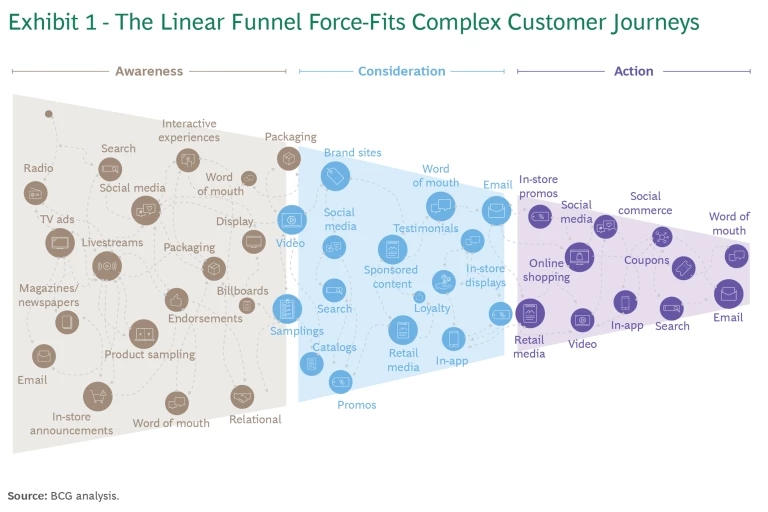
This flexibility becomes possible by shifting from the linear funnel to “influence maps.” (See Exhibit 2.) Modern consumer journeys revolve around four key behaviors: streaming, scrolling, searching, and shopping. Unlike the rigid, sequential approach of the funnel, where each of these behaviors is confined to specific stages, the influence map recognizes that they occur across the entire journey, often overlapping and influencing multiple stages simultaneously.
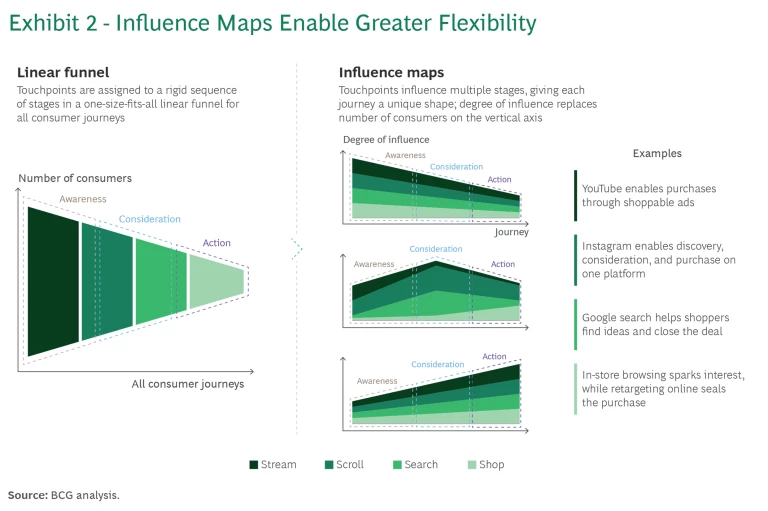
As shown in Exhibit 2, the vertical axis of this new construct represents the degree of influence—that is, a brand's ability to meaningfully affect consumer decisions and outcomes, thereby accelerating the journey from awareness to action. Moreover, the influence map replaces the assumption that one size fits all by tailoring strategies to each specific consumer journey, resulting in many different maps. This flexibility ensures precision, allowing marketers to navigate and influence each journey more effectively.
The influence map is a reimagining of the linear funnel that reduces artificial barriers between stages and ensures the right level of customization for each journey. In Exhibit 3, this is illustrated by two real-world scenarios:
- Journey A describes the “impulse strategist,” a spontaneous, digitally savvy shopper who enjoys discovering new refreshing beverages and planning purchases for future use. He might see an ad for a product while streaming YouTube, then encounter a prominent in-store display, search for product reviews on retailer sites, and ultimately use a digital coupon to make a purchase.
- Journey B describes the “smart saver,” a budget-conscious shopper who is undecided on a brand. Her journey starts with a quick online search to compare options. Then, while scrolling on social media, her attention is grabbed by an influencer’s post showcasing a product that fits her needs. Intrigued, she taps “shop now” and completes the purchase directly in the app.
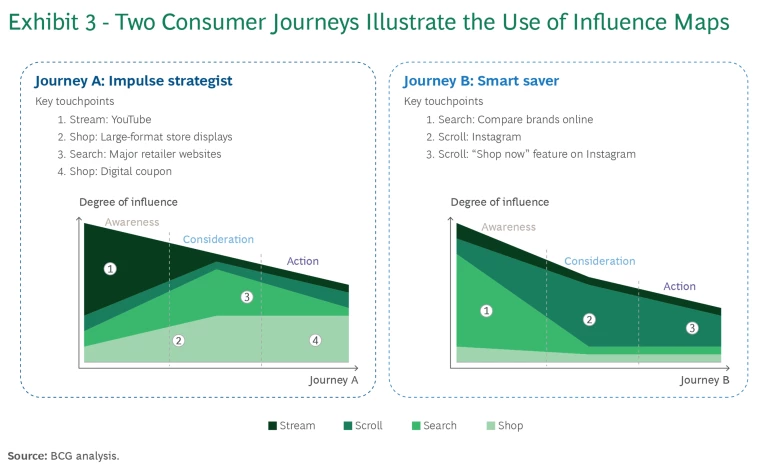
Both journeys highlight the importance of accurately observing consumer behaviors to plan for influence. By identifying the most influential touchpoints in each journey, marketers can align touchpoints, content, and resources with specific consumer needs for maximum effectiveness.
Subscribe to our Marketing and Sales E-Alert.
Reach Does Not Guarantee Influence
As marketers consider new planning models, they must also reevaluate the outcomes that they seek to optimize—ensuring that they select touchpoints that drive both reach and influence.
More than just visibility, influence is determined by three factors: the level of attention paid by a consumer at any given moment; the relevance of the marketing content to the consumer’s needs; and the consumer’s degree of trust in the touchpoint or platform. These factors, combined with reach, should guide marketers in prioritizing touchpoints.
While reach is still essential, it is crucial to keep in mind that different types of reach do not have equal value in terms of influence. High-reach touchpoints give brands wide exposure, but they don’t always drive influence. (See Exhibit 4.) For example, marketers focused solely on reach may incorrectly assign equal value to an ad that consumers scroll past quickly, to a 15-second nonskippable video, and to content that captures minutes of attention and creates a lasting impression.
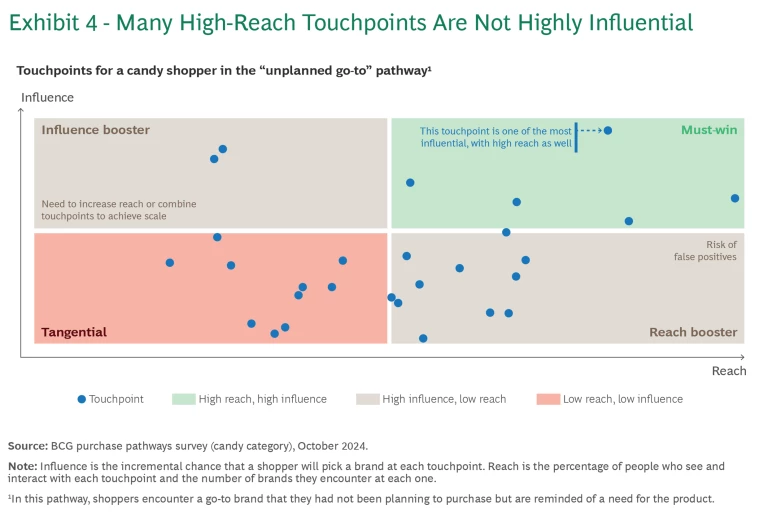
Maximizing both reach and influence requires understanding not only where to find consumers but also how to address their needs effectively. For instance, a well-placed search ad that appears at the top of a results page can achieve high reach and influence when it aligns closely with what consumers are seeking, providing relevant and timely information that guides them toward a decision.
Plan for Influence and Execute with AI
As marketers contend with the complexity of modern consumer journeys, they need ways to address distinct journeys in a bespoke manner, even with constrained resources. This is where AI and GenAI come in as powerful enablers, helping marketers streamline efforts, optimize influence, and increase targeting precision.
Over the next decade, winning marketers will use AI to help execute tailored approaches for each journey. However, success with AI requires a fundamental shift in perspective; using AI within outdated frameworks, such as the linear funnel, won’t deliver optimal results. Instead, marketers must focus on planning for influence through the following steps:
- Understand how consumer journeys are influenced by touchpoints. Marketers will need fresh research and insights to understand the top consumer journeys in their category and to identify the most influential touchpoints within each one. Influence research should combine insights on touchpoint reach with metrics for attention, relevance, and trust across every consumer journey.
- Consider touchpoints holistically. All touchpoints that influence consumers—not just ads—need to be evaluated through the same lens. These touchpoints can be earned (like influencer endorsements), owned (like websites or branded experiences), or jointly developed (through partnerships).
- Build bespoke plans for each journey. Marketers require customized plans tailored to each consumer journey, addressing specific needs and preferences at every stage. These bespoke strategies will help optimize engagement by aligning touchpoints and messaging with each journey's specific dynamics.
Because of limited resources for creative and campaign execution, marketers have traditionally struggled to create bespoke plans for the countless potential consumer journeys. Predictive AI and GenAI promise to give marketers the ability to move to an influence map model, offering new capabilities based on real-time consumer behavior.
GenAI accelerates content production, with early adopters reporting up to four times faster content generation and five times faster copywriting. By automating tasks such as content localization and real-time copy adjustments, the technology allows brands to produce more relevant, effective content that resonates with consumers.
AI can also direct marketing spend to the most effective touchpoints, ensuring that budgets are aligned with the highest-impact channels. The vast majority of CMOs have already adopted GenAI and plan to launch AI-powered products and services, demonstrating its potential to refine how brands interact across diverse touchpoints.
Finally, AI optimizes resource allocation and strategic media placement, ensuring maximum relevance and reach at each touchpoint to make every dollar count.
How to Get Started
A BCG study involving more than 2,000 marketers found that 80% of companies are still in the early stages of AI adoption—exploring off-the-shelf solutions, adopting use cases, and generally still experimenting. Meanwhile, 20% of companies are integrating AI into their workflows and building end-to-end solutions. These more advanced AI adopters report 60% higher revenue growth than their peers.
For CMOs, building AI excellence requires a shift in mindset for their organization, including new planning frameworks and talent strategies and redesigned ways of working that emphasize human–AI collaboration. To get started, marketers can take the following steps:
- Plan for influence
- Run research to identify the top “influence pathways”—that is, the most influential consumer journeys—for your category.
- Create influence maps to better understand the roles of stream, scroll, search, and shop in your category.
- Redesign marketing plans to maximize the influence you can deliver across these channels.
- Execute with AI
- Assess the maturity of the organization’s AI adoption to determine readiness relative to benchmarks.
- Identify the steps in the end-to-end workflow where AI could play a role—for example, insights and measurement, media, or creative.
- Prioritize the top influence pathways in which to deploy AI pilots.
The next decade of marketing will belong to those that can master the intricate interconnection of reach and influence. As marketing moves away from the funnel model, the influence map will become the framework for success, allowing brands to evolve from broad reach to meaningful, high-impact engagements that drive growth. By embracing AI and understanding the complex, fragmented consumer journey, marketers can craft more effective strategies, drive better outcomes, and lead with this new marketing paradigm.









